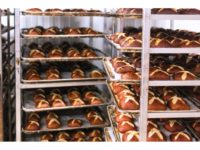Filling in the Gaps
by Andy Hanacek
Through innovation and by rolling out super-premium desserts that rival their restaurant counterparts, the pie category is trying to make the popular holiday dessert less of a seasonal item in the eyes of consumers.
Where were you on Jan. 23, 2005? Although it wasn’t a day that will live in infamy for most people, it certainly is marked on the calendars of every pie-loving, pie-making person in the United States. Jan. 23 was National Pie Day — a day that the American Pie Council (APC) spreads the word about pies, trying to keep them fresh in the minds of the Americans and help consumers get past viewing pies as seasonal items.
Pie producers are developing tantalizing new entries, including ones with new flavors and fillings and more exquisite and elaborate toppings, which they are using to battle the seasonal sales swing that affects the category.
The pie, a traditional slice of American culture and an icon representing family and friends gathering together, is, for those reasons, quite popular around the holidays and during the summer months. But demand, and thus sales, is frequently uneven throughout the year.
Beyond the seasonality, though, the category has experienced a resurgence, says Linda Hoskins, executive director of the APC.
“The variety of new flavors has expanded considerably in recent years,” she says, “and co-branding with well-known candy and cookie brands has had a positive impact on sales.”
| TOP 5 Brands Frozen Pies (For 52 weeks ending Jan. 23, 2005) | ||||||
| Rank | Brand | Dollar Volume (in millions) | % Change | Dollar Share | Unit Sales (in millions) | % Change |
| 1 | Mrs. Smith’s | $103.4 | +7.0 | 31.6 | 29.5 | +15.8 |
| 2 | Edward’s | $56.3 | +4.0 | 17.2 | 14.5 | +1.5 |
| 3 | Marie Callender’s | $47.3 | +5.0 | 14.5 | 9.1 | +0.1 |
| 4 | Sara Lee | $40.4 | -11.0 | 12.4 | 13.5 | -10.5 |
| 5 | Mrs. Smith’s Special Recipe | $12.4 | +6.3 | 3.8 | 2.3 | +12.4 |
| TOTAL* | $326.8 | +2.3 | 100.0 | 87.4 | +3.4 | |
| *including brands not shown Source: Information Resources Inc., Supermarkets only | ||||||
| TOP 5 VENDORS Frozen Pies (For 52 weeks ending Jan. 23, 2005) | ||||||
| Rank | Brand | Dollar Volume (in millions) | % Change | Dollar Share | Unit Sales (in millions) | % Change |
| 1 | Mrs. Smith’s Bakeries | $131.8 | +3.4 | 40.3 | 36.6 | +10.8 |
| 2 | Edward’s Baking Co. | $64.8 | +3.6 | 19.8 | 16.7 | +1.0 |
| 3 | Sara Lee Bakery Group | $61.7 | -5.8 | 18.9 | 18.7 | -8.8 |
| 4 | American Pie | $51.9 | +7.5 | 15.9 | 9.8 | +1.9 |
| 5 | Quality Baker Co. | $3.1 | -21.3 | 0.9 | 1.1 | -19.7 |
| TOTAL* | $326.8 | +2.3 | 100.0 | 87.4 | +3.4 | |
| *including brands not shown Source: Information Resources Inc., Supermarkets only | ||||||
The APC is working hard to convince players in the industry to unite and grow the category together, but Hoskins admits that challenge has been a tough one because of competitive issues in the market. Also, recent pie company consolidation, such as Schwan’s purchase of Mrs. Smith’s from Flowers Foods in 2003 and the sell off of Country Home’s assets following its fall into bankruptcy, have substantially reshaped the marketplace.
Still, growth in other areas, such as multi-layered pie products and individual and portion-controlled pies, has built some positive momentum for the industry.
Although the forecast for pies looks good, trans fat has yet to move beyond the doorstep of the slower-moving pie industry, and not all manufacturers have rushed to address its impending arrival.
Jim O’Sullivan, senior vice president and general manager for the retail division at Schwan’s Bakery Inc., believes that the pressure to reduce trans fat is not only on the pie manufacturers.
“Much onus will be put on the ingredient suppliers to deliver workable solutions that will offer the same taste qualities as the current products while reducing the amount of trans fat in the products,” O’Sullivan says.
Felicia Carlson, marketing manager for Nancy’s Pies, Inc., believes that trans fat isn’t the biggest upcoming trend, however.
“The in-store bakery industry will be de-emphasizing the ‘two for $5’ pie and re-emphasizing the need for a foodservice-type pie presentation,” she says. “Créme pies, meringue pies, gourmet fruit pies — these strong, eye-catching, impulse sales I believe will be the next trend.”
Innovation is giving the pie category a tool to promote awareness, Sara Lee Corp. has broadened its line with new Signature Selection varieties such as Key Lime, Strawberry and Cream, Lemon Meringue and Chocolate Dream, “which if you love chocolate, it’s to die for,” says Rich Noll, outgoing president and CEO of the Sara Lee Bakery Group.
As a result of such innovation, pies are getting better coverage in the media. Hoskins believes these signs point toward growth and increased profitability.
“News about pies is being picked up by the media on a regular basis today, a trend that has only recently begun and is expanding,” Hoskins explains. “[On National Pie Day], we were asked for an interview by our local NBC affiliate in Chicago and on the CBS affiliate in Orlando on the morning news shows.”
Among the top innovation goals at Schwan’s is portion control, where the company has initiatives addressing that trend across all channels of sale, O’Sullivan says. Specifically, in many areas of the country, Schwan’s offers twin pack slices of its top-selling pies under the Edwards and Mrs. Smith’s brand names.
“Single-serve portions can definably attract new consumers, as they can be consumed at more occasions than traditional whole pies, such as a quick snack for one,” he explains. “Also single-serve pies offer the ability for multiple people within a family to enjoy their favorite flavor versus a whole pie of one flavor.”
In fact, the attraction has already begun, O’Sullivan states. According to ACNielsen data, for the 52-week period ending Feb. 5, 2005, portion-control pies are up nearly 17% in the retail segment. Compared to the flat growth experienced in the entire pie category, manufacturers might be able to use that as a stepping stone to improve the category.
Noll adds that the Sara Lee’s frozen division is also adding convenience to the freezer case by packaging desserts in plastic domes so consumers can take a slice out and reseal the rest for another day.
Despite the fad diet craze, the frozen dessert category continues to grow. At first, that may seem counterintuitive, but consumers perceive such desserts as an indulgence they use to reward themselves a couple of times a year. That’s why the company hasn’t come out with low-calorie or low-carb options. “It’s all about great taste,” he says.
On the equipment side, manufacturers are also being spurred on by innovative products. Specifically, toppings-application processes have improved, Carlson says, and she believes those will continue to fuel growth in the category.
Over the years, pie line speeds have in some cases doubled or even tripled to upwards of 120 pieces a minute. Ultrasound slicers and other technology also allow bakers to produce pre-portioned cream pies and other difficult-to-handle products with greater consistency and efficiency.
Because pie tops are getting fancier, Hoskins adds, innovative equipment is required, and more manufacturers are looking for higher levels of automation and efficiency throughout the pie-making process.
But the biggest things the pie industry has going for it have more to do with tradition than anything else, Sullivan says.
“We continually see consumers seeking more comfort foods as a way to escape their hectic lifestyles and hearken back to a time when the pace of life was slower,” he notes.
Add to that the fact that pies are embraced as a traditional comfort food, says Carlson, and the future looks bright for pies.
“In times of political, economic and military uncertainty, it is always nice to have a reliable comfort food available,” she says. “Baseball and apple pie may seem ‘old-fashioned,’ but some things just never go out of style.”
The next step is to help consumers transfer the comforting aspects of pie to year-round demand. Once the pie industry finds a way to fill the valleys on the demand curve, momentum should build and the pie industry will fly high.




